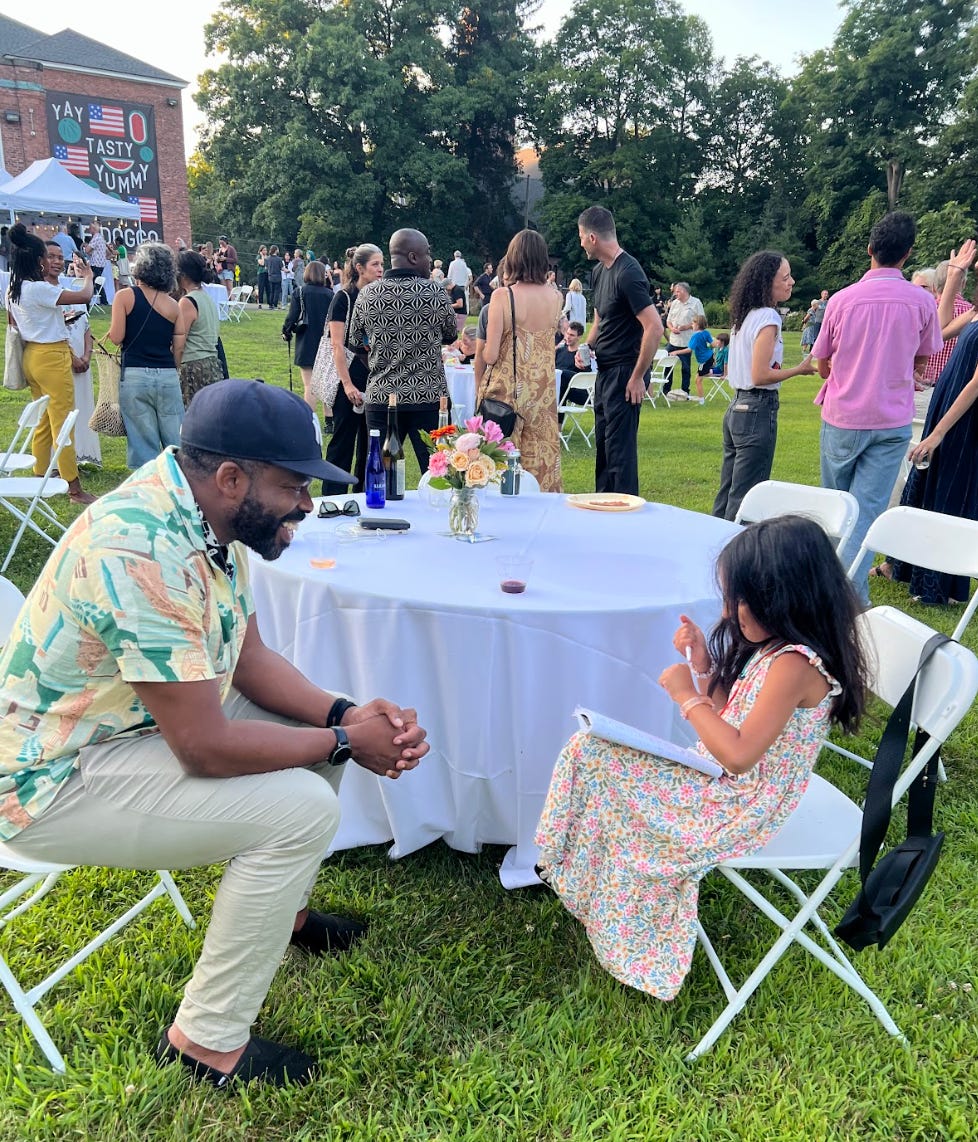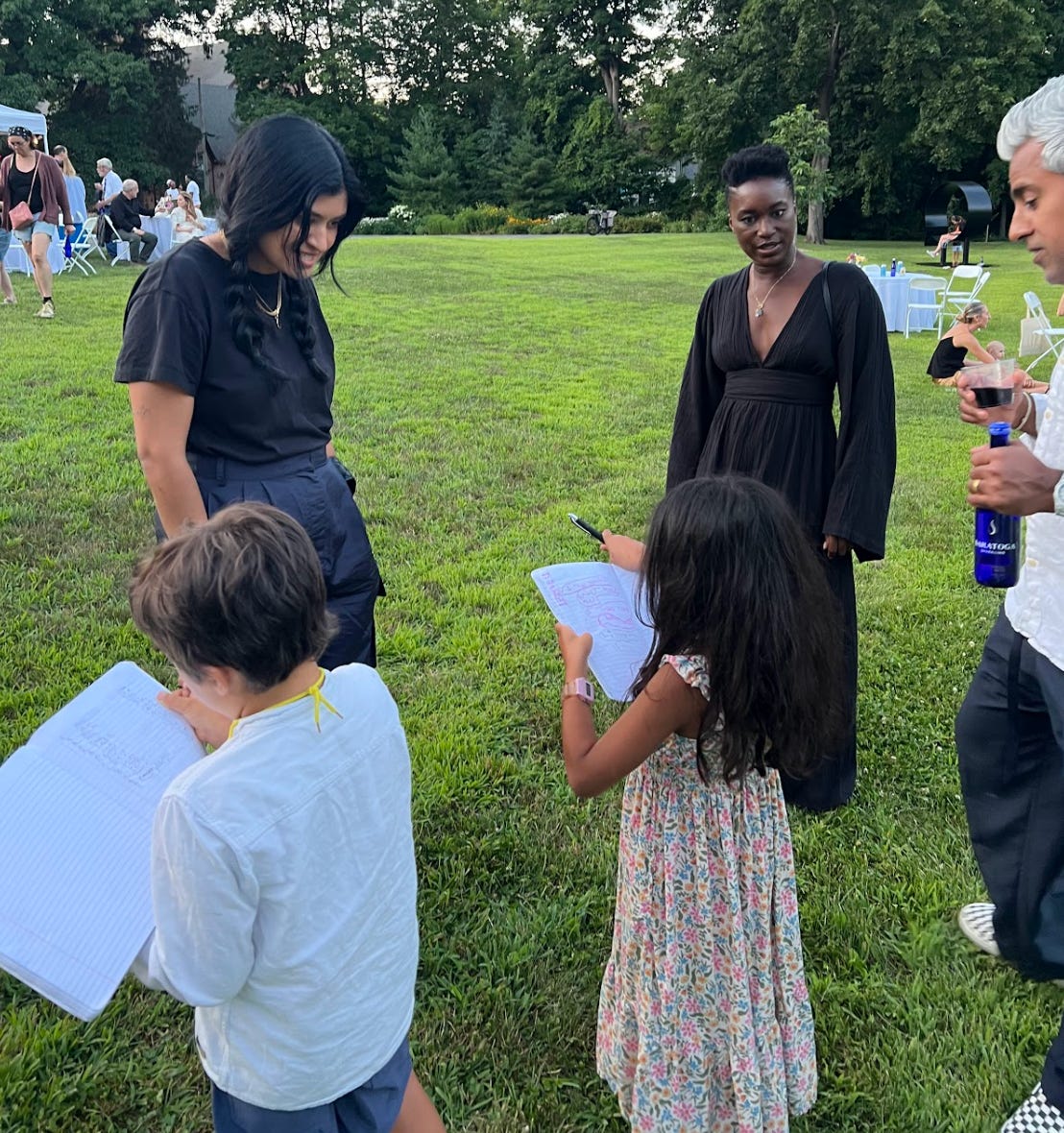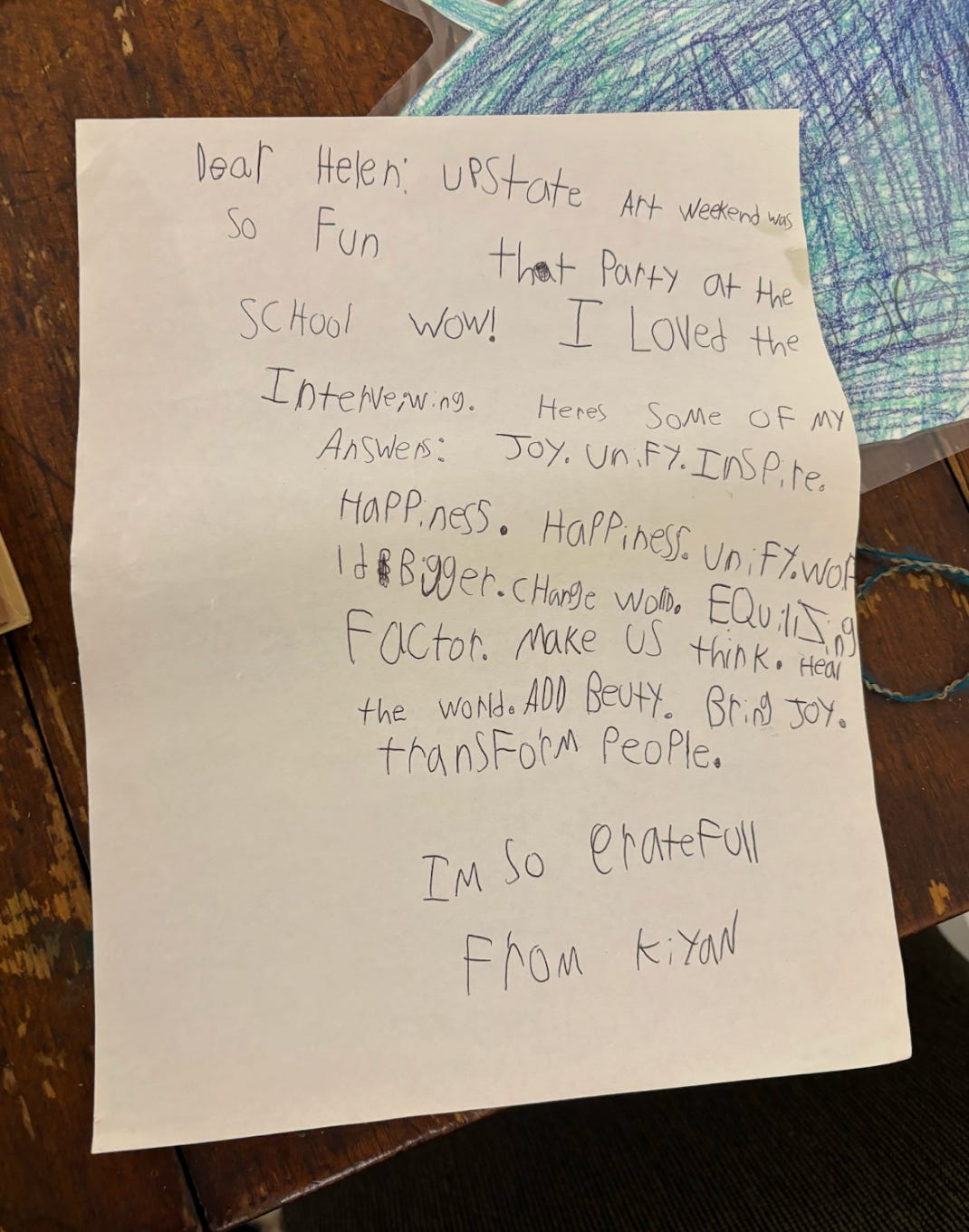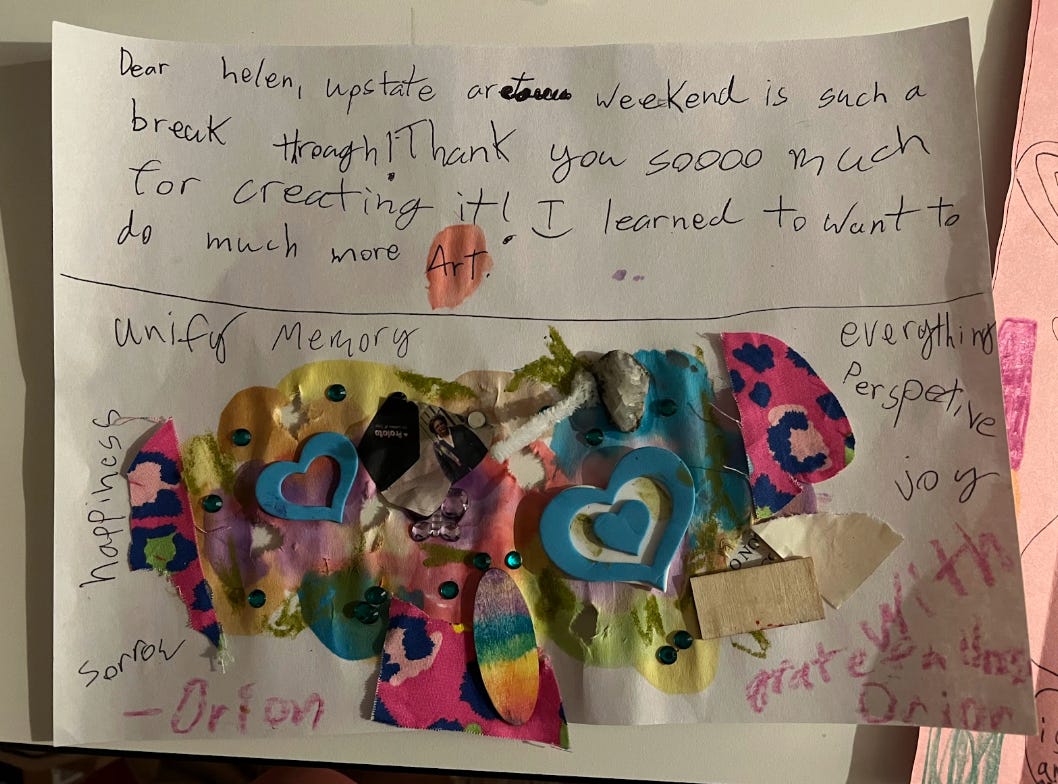How to include kids without centering them
Because including kids shouldn't mean losing everyone else.
Last summer, a friend invited my husband, our two kids, and our nephew — ages 6, 8, and 9 at the time — to the opening of Upstate Art Weekend, a sprawling outdoor art festival. The air was buzzing: artists welcoming strangers into their studios, dancers warming up under trees, friends reuniting in pop‑up galleries. It was the kind of setting that usually screams “no kids”: unspoken adult rules, fragile pieces on pedestals, long conversations. And yet, there we were with three kids in tow.
We’ve been told that Americans don’t party anymore. And in the rare cases we do, it’s often siloed into micro-generations: parents with parents, singles with singles, kids with kids. Intergenerational gatherings feel increasingly rare and with good reason: parenting is more intensive, childcare networks are thinner and privatized, families live farther apart, and, post-COVID, home can feel safer than venturing out. Then comes the practical side: Will the kids eat what’s served? Will they vanish into screens? Will they be a royal pain in the butt? 😬
I’ve noticed that when the kids are present at our gatherings, we tend to oscillate between two extremes — designing the event entirely around them or ignoring them altogether.
We’ve been holding a question live in our own family: Can you meaningfully involve kids without centering them at an intergenerational gathering?
That night at Upstate Art Weekend, my husband handed each of them a $3 reporter’s notebook and a mission: ask as many guests as possible — artists, strangers, friends — “In one word, what can art give the world?” Whoever collected the most answers would get a cookie. They practiced their lines: “Hi, I’m Orion. What’s your name? May I ask you a question? In one word, what can art give the world?” At first they were hesitant, but as they practiced, they became more intrigued. With the notebooks and a pen in hand, they looked as if they'd been handed keys to a magical kingdom.
They fanned out, introducing themselves to friendly-looking adults, and asked if they could ask them a question. The adults would look at them with curiosity, listen to their question, smile, and then often take a moment to really think before responding.
As the night bloomed, the kids became like bees cross‑pollinating the party, moving from table to table. The one‑word prompt worked well: easy for the kids to remember, and enough of a constraint for an adult to answer. The question was also relevant to the purpose of the event. (The cookie didn’t hurt either.) Meanwhile, we (as the parents) got to have real adult conversations, while keeping an eye on them.
By the end of the night, their notebooks were full of words: “Joy.” “Unify.” “Inspire.” “Happiness.” “Equalizing.” And they were so excited and proud. The kids weren’t just tolerated. They were transformative. The kids’ question cracked open conversations, and gave adults a moment to pause and explicitly consider the question at the heart of the weekend: what is the purpose of art? And the kids had a playful, age-appropriate way to engage.
We had stumbled on a way to meaningfully include the kids without centering them. The straightforward device my husband came up with was generative to the group. It was also age appropriate to our kids. He is a journalist, and he found a way that made sense to him. You can do the same.
Whether you’re hosting a family dinner or attending a long-overdue reunion, here are 3 ways to spark more life and connection across generations:
1. Give kids a task that's fun, they’re capable of, and that sparks connection.
One New Year’s Eve a few years ago, we couldn’t land a sitter. A Belgian friend who was hosting said of our kids, “Bring ‘em!” Our kids were old enough that we wanted them to have a good time, but there weren’t going to be other kids there. We wanted to set them up for success for the evening, while also letting us engage with others. My husband (he’s clearly getting good at this) gave our kids a role they were excited about: my daughter, who loves to draw, asked guests if she could sketch their portrait. My son, who makes animals out of tin foil, asked guests their favorite animal and made it for them. It’s not rocket science, but it gave each kid an organic, natural way to have social permission to engage with an adult in a way that felt festive. Also, interestingly, multiple people told me how nice it was to have an excuse to sit still while my daughter sketched them. (The introverts were especially grateful for the breather.) The kids were part of the evening, but not the center.
2. Ask a cross-generational “Magical Question.”
A few weeks ago, I sat at our dinner table with my kids and nephew. They were spiraling into a movie-night argument when I redirected: “Let’s ask a magical question instead.” (Close readers will know that I define a “Magical Question” as a question you ask in a group that everyone is interested in answering, and everyone is interested in hearing each other’s answers.) My daughter suggested one: “What’s the naughtiest thing you've ever done that was worth it?” We all cracked up. And were very interested in each other’s answers. And it changed the night. We took turns telling stories others hadn’t heard. It was honest, fun, and slightly transgressive! Kids are funny. They also like learning skills. It is a learnable skill to formulate a magical question for a group. It is also a learnable skill to tell a story in a group. And, it takes practice.
3. Use objects to connect across age.
My elderly father was visiting recently. I’ve been thinking about how to help him more meaningfully connect with my kids as they grow. My daughter had recently been asked by her teachers to bring in three objects to share with the class that reflected a part of her. I mentioned the assignment to my father, and asked him if he might want to do the same: pack three objects in his suitcase that represented pieces of him he wanted the kids to know. He did it with gusto. And, it kind of organized the visit. Every day he would pull out one object from a paper bag he brought with him, and share what it was and the story behind it. It became a daily ritual between them. He brought a fuchsia crystal and explained how, as a boy, he’d walk dried riverbeds with his father, who had the uncanny ability to spot which rocks held crystals. My kids were transfixed as he showed them one such rock. The objects gave them a shared focus across their very different ages.
A crucial skill of group life is learning how to design for connection across difference. And though we may not think about “age” as a difference, it is. And, when we spend just a little time thinking about what kind of threads and permissions we give people to create a different kind of interaction, the entire group is better (and more resilient) for it.
Every family is different, and this might not work for every scenario. (I am also really talking about school-age kids in terms of fostering real connection.) But when we include kids without centering them, we’re teaching them how to be part of a shared life, and reminding ourselves how to live one.
I’d love to hear from you, when have you experienced the magic of an intergenerational gathering or practice or activity?
Warmest,
Priya
Upcoming Events
SEP 24 @ 12PM EST: GROUP HELP: My next GROUP HELP Session is coming up on September 24 at 12pm ET: GETTING UNSTUCK: How to Host a Gathering You Actually Want to Attend — including the five biggest blockers I see in gatherings and how to move past them.
(Psssttt… we shaped this topic straight from what you all asked for in the GROUP CHAT.)
I am opening the first two GROUP HELP sessions in September to all of you as part of launch celebrations, and to let you try them to see if you’d like to become a GROUP LIFER. 🎉 Going forward, these GROUP HELP Sessions will be for paid subscribers to build our skills together in community. Please join us. I’d love to have you there.
SEP 30 @ 12PM EST: TALK TO YOUR BOYS LIVE: On Tuesday, September 30 at 12pm EST, I’ll be going Live on Substack with Christopher Pepper and Joanna Schroeder, co-authors of Talk To Your Boys: 16 Conversations to Help Tweens and Teens Grow into Confident, Caring Young Men. I read the galley this spring and it is brilliant, practical, and based on a radical idea: parents should have many deep and open conversations with their sons — not just daughters. Join us on Substack for this lively, relevant conversation.







I'm going to share this with the programming folks at my church. We are at a real crossroads, being the rare urban parish that is actually growing, largely because of families with young kids, but it comes with tension. The older more tenured parishioners are resentful at times of the noise, the chaos, and the communications and programming targeting (it sometimes feels like to them) exclusively families with kids. I think some of these ideas could go a long way making the "old timers" feel like they haven't disappeared, whilst building bonds across the generations.
My word, this post made me teary. (Full disclosure, I have been under the weather and my emotional and verbal filter may be shredded, but still.) I, already and for quite some time, considered you two amongst the most brilliant and constructive people I am aware of in the world. And as a middle-aged pediatrician who struggles with the phenomenon of “all about the kids or no kids” on a regular basis, while simultaneously bemoaning our culture’s emphasis on doing everything “independently,” and being a seemingly futile advocate against this approach to raising children (seriously, it actually does “take a village,” and that could be both normal and fun if we approached it differently!), this post literally made me want to jump up and dance. Except I feel like cr** so that’s not happening lol .Thank you. So very delighted and grateful you are here.